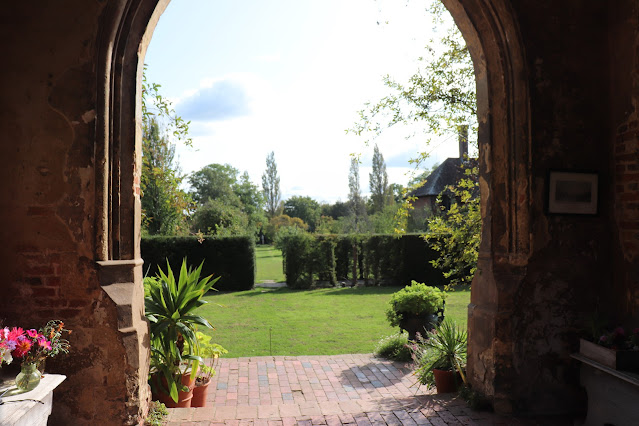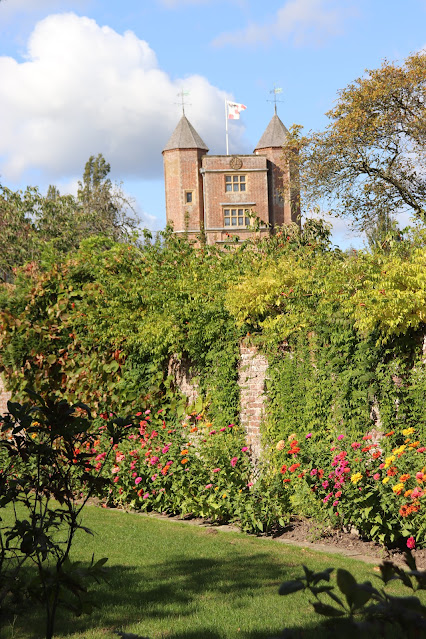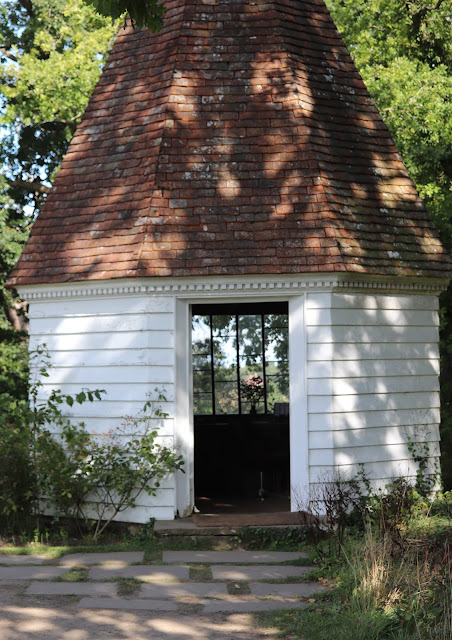Let's Go: Sissinghurst Castle Garden Part I
Sissinghurst Castle Garden is largely responsible for my gardening obsession. Years ago my dearest friend gave me a copy of Gardening at Sissinghurst by Tony Lord, and that fueled many hours of daydreaming. Even in photographs the garden exudes that potent element of unabashed romance, done better than any other I know. The Tudor bricks, the historic ruins and romantic walls climbing with roses sparked in me possibilities and opened up a new language. Though I don't garden in this style myself, what it taught me was to dream big.
At its heart is Vita Sackville-West (1892 - 1962) and her husband Sir Harold Nicolson (1886 - 1968). They sought not to create a garden for the world to enjoy, rather they created it for themselves, a sanctuary overflowing with Vita's roses juxtaposed with Harold's architectural boundaries. Now in the hands of the National Trust, it is one of the organization's most visited sites and one of the most cherished gardens in England with more than 100,000 visitors each year.
Built in the mid-16th century, Sissinghurst tower is next to Vita's famous White Garden, its most iconic image. It was this "castle" tower that had Vita in love with the property at first sight. She saw its potential and would claim this tower as her own, her refuge, her writing room where she penned some 13 novels, poetry, short stories, diaries and a regular column in The Observer.
The long history of Sissinghurst Castle Garden is complex. Its early history dates from the 10th century, the name derived from Saxon word "hurst" meaning forest. It was originally a Saxon pig farm. From the National Trust website:
The Tudor buildings were used as a prison for up to 3,000 French sailors who were captured by the British during the Seven Years War, between 1756-63. Held for months at a time in vile, stinking conditions, the prisoners lived in 'cells' with little access to fresh air, clean water or adequate food supplies. The sailors referred to Sissinghurst as 'le chateau' hence 'castle' being adopted into its name, although not a direct translation.
Not a true castle, but from the French translation and perhaps a bit of cheek as the famous tower was more of a gate house than fortress. It was also heavily damaged during this period; the former Elizabethan palace is more walls than palace these days. It was also home to a poor house in the 18th century and the women's land army during WWII.
Vita purchased Sissinghurst in 1930 for the princely sum of £12,375 and so began their long love affair with its 460 acres, Tudor buildings, iconic tower and a whole lot of potential. It was in fairly bad shape and unlivable at the time, but with enough money and imagination it was transformed into what it is today. Although Vita and Harold had privilege and came from money, they both found it necessary to work as such a place was and is extremely expensive to maintain. They could not afford to add many features they wished at the time (such as stone paths) due to limited funds. The fact that they had staff (chauffeur, cook) nonetheless translates to privilege to me.
They created a garden in a place that was full of ghosts and literally centuries of garbage. Views of the five-acre formal gardens divided into garden rooms, the working farm plus the hundreds of acres of estate that surround the tower. More on this to come.
Backtracking to the beginning, this is where FM and I began. A long walk from the village of Sissinghurst bus stop up to the gardens past these oast houses used for drying hops, a reminder that this estate was a working farm in Harold and Vita's day.
The gardens were not open yet so we grabbed a cup of coffee at the restaurant to have a pause. Straight ahead to the right is The Long Library, to the left is the gift shop, formerly a piggery.
The Elizabethan barn with the restaurant on the left (former granary) and gift shop on right.
Adequately caffeinated we went exploring, this is the back side of the barn.
Interior of the barn.
The Kent countryside opened up before us as we stepped through the arched opening in the barn.
The vegetable garden is fairly new and provides produce to the restaurant. We enjoyed this familiar-feeling garden and were reminded of our own garden and the never-ending chores awaiting our return.
Doing a bit of good for the soil, indeed.
FM lost in fields of veg. The oast house and tower can be seen in the distance.
Now that the grounds were open, we headed for the entrance to the garden through the archway in the Long Library.
Having stepped through the archway, now looking behind.
The Elizabethan tower with its octagonal turrets and rather large Irish yews Vita preferred as shaggy specimens rather than formally clipped.
Looking through the ground level to gardens beyond.
One of a pair of lovely wooden benches inside the archway to the tower.
Up its 78 steps to the top of the tower, an overview of the gardens below I found most helpful and amazing. The roundel of clipped hedge is the center of Vita's famous rose garden.
The Priest's House, right, is where Vita and Harold's son's had their bedrooms as well as the family kitchen and dining room. The gardens that surround it are known as the Delos gardens, Mediterranean in style.
The rounded Powys wall in the rose garden can be seen here, built in 1935.
Looking out past the yew walk and orchard towards the moat, one of the oldest features of the property.
A recent renovation of Vita's writing room on the third floor of the tower. It was closed off save for an iron gate, but my camera fit through. It is said to be preserved in this way as Vita allowed nearly no one into her sacred and favorite space where she penned all of her written works. Her son Nigel recalls having only been inside five or six times in his life before his mother passed away. Pretty much everything here is original and of special meaning to Vita.
Harold created the formal lines, the hedges and layout of the garden; n no easy task. If you look at a map of the estate it is clear there is no grid format at work and many areas connected at odd angles. Harold was able to connect areas and create site lines so when in the garden, it flows.
In The Nuttery, a wooded area of hazelnuts and shade lovers.
The moat is the oldest remaining part of the original manor house first recorded around 1100 and called the place Saxingherste, meaning woods settled by Saxons. The original moated manor would have been owned by the Saxingherste family. There are two of three arms remaining of the original moat, the third became The Moat Walk. A sculpture of Dionysus in a niche at the edge of one arm of the moat, the original sculpture having been replaced in 1995.
From the Moat Walk looking towards the tower. This brick wall, unearthed shortly after Vita and Harold purchased the estate, is thought to have been a part of the medieval manor house, predating the Tudor buildings.
Nigel Nicolson's summer writing gazebo/office built in 1969 to honor his father.
From the edge of the moat looking through the orchard towards the tower on a perfect English day in Kent.
Towards the southeast corner of the gardens near the moat is the herb garden, one of my favorites.
A chamomile seat in the herb garden called Edward the Confessor's chair made from fragments of masonry around the property by Jack Copper, the chauffeur. Clipped yew hedges behind.
Simply a favorite, likely for its simplicity. The three lions sit atop an old millstone, the lion bowl was purchased in 1914 (in Cospoli, Turkey) by Vita and Harold who were living in Istanbul at the time. The bench in the background was based on a 17th century wainscot chair and is made of oak, as all wood benches at Sissinghurst are, as it ages to a lovely silver shade. Its back has a curvilinear line rather than a straight one so it didn't draw attention to the uneven clipped hedge behind. The stone paths of the main axes are made of York stone, an improvement from Vita and Harold's day.
A lovely couple calling themselves Vita and Harold were enjoying a good giggle in the herb garden. I decided to honor them and the joy they expressed by including them.
A tribute to Vita from Harold in "her" tower.
Sissinghurst is a fantasy created by Vita's romantic vision and Harold's love of formality and order. It was her grand masterpiece, a private sanctuary for their family and circle of friends. It was innovative for its time - no straight lines of bedded out plants here - creating borders with color themes, harmonies and texture, exactly what Gertrude Jekyll was teaching at the time, though Vita and Harold did it their own way. Much of what is here can be taken for granted and written off as early-mid 20th century privilege or old-fashioned. It is one of the first to depart from garden norms of the time, it is Vita's vision. Even today it is more than that. In an age when naturalistic and rewilding are the direction gardening is heading, Sissinghurst is evolving as all good gardens do. The decision was made to stop irrigating (save for containers and new plantings), you can read more about that here. And you know what? It still looked fabulous. Granted, England's summers are much wetter than our own, it is still a bold move in the right direction and is keeping Sissinghurst relevant in the twenty first century.
To be able to visit such a personal inspiration was a highlight of our trip to England. As is true with most daydreaming, seeing a place in person vs. imagining it or living it through photographs is often quite different. It was smaller than what I envisioned, even though the formal gardens span some five acres. That did not take away from its romance, rather its more intimate feeling was endearing.
This half of my visit to Sissinghurst covered the chronological first half of our visit. Next time we'll catch up with the rest of the gardens including the famous White Garden. And as a final note, a lot can be (and has been) written about Vita and Harold's unconventional and successful marriage and their personal lives. While they were fascinating, loving, interesting and perhaps considered scandalous, I am out of my depths writing about people and whom they love.
That's a wrap for this week at Chickadee Gardens. As always thank you so much for reading and commenting, we love hearing from you! Happy gardening!




































.JPG)






I became interested in gardening though an interest in Elizabethan textiles and the realization the flowers depicted there could still be grown and were still growing all over England. I think one of the fascinating things about Sissinghurst is the fact that Vita would not have been looking for a place like this if she had been able to inherit her childhood home of Knole. The loss of Knole resulted in the creation of Sissinghurst in my view. Imagine the gardening world without Sissinghurst. Love that view of the interior of the barn. It is always so rewarding seeing a garden like this through the eyes of another gardener. You might enjoy Adam Nicolson's (Vita's grandson) book about living there and his ideas about the property.
ReplyDeleteThat is a fascinating and cool way to dive into gardening! You are so right about Vita and Knole - a silver lining for all of us garden enthusiasts and probably for Vita, for had she inherited Knole she may not have stretched her gardening wings as much. I appreciate the recommendation of the book, I actually want to read all the books both about and by Vita and Harold and Sissinghurst. Cheers!
DeleteIt had to have been massively thrilling to visit a garden estates that is "largely responsible" for your gardening obsession.
ReplyDeleteWhen I read about a moat and a manor house from around 1100... I get weak in the knees. Camelot and the Knights of the Round Table maybe fictional, but my imagination is picking up the slack.
I'm glad you snapped a photo of Vita's room. Why is a forbidden room always so tempting? I would have loved to walk through the stone archway into the back alcove, covered floor to ceiling with books.
Chavli
It was massively thrilling, Chavli! Totally. I too get weak in the knees when it comes to history, a favorite subject for sure. Love your imagination, that keeps the world going round so keep it up!
DeleteYes, the Forbidden Room was so delicious. I would love to have snooped through it all.
Wonderful! I've often read about the place, seen many pictures. But in your little tour I've seen parts I'd hadn't before, and it's given me a much better idea of the layout. Well done!
ReplyDeleteOh, I'm thrilled you gained something different - I actually thought of you a lot while writing this post - thinking you would so appreciate the architecture, the sculptures and history. Thank you!
DeleteThanks for sharing the history of the house and garden and the overall layout of both. I look forward to part 2.
ReplyDeleteYou're welcome, Kris! Part 2 coming soon!
DeleteSuch a great read, thank you! Vita's garden journalism is still worth reading. And as Linda notes above, Vita may have been from the upper classes and assumed to be privileged, but as a woman she was struck from inheriting her beloved childhood home Knole -- "home" in this case being a very grand estate -- and because of that indignity Vita often quoted Elizabeth I, "Had I been crested and not cloven, my Lords, you would not have dared to treat me thus!" I visited way back in '93, so good to see it again!
ReplyDeleteThank you Denise! I really wish to track down some of her writing. I love that quote by the way. I wonder - has it changed much since you saw it? Read part 2 next week and let me know ;)
DeleteI'm so envious! Like you, I've always been fascinated by the garden and the makers. I've read numerous books about them. It is the one garden I'd love to see the most.
ReplyDeleteOoh, it's worth it, just go in the off season if possible. I hear spring and summer are chaos. I hope you get there someday! We stayed in Cranbrook at the George Hotel which is close by.
DeleteThis was a delightful post to read, thank you for taking the time to be so thorough. Your images have me feeling like I was right there with you.
ReplyDeleteThank you Danger! I'm glad you got that feeling! More to come....
DeleteVery lovely tour. I am especially enchanted with that old brick barn. Brick is such a great complement for garden greens. The Delos gardens really stand out as quite different from the other photos, with all the bare soil and grays and russets, compared to the deep, vibrant green everywhere else. Reading about Vita and Harold - It's wonderful to see how two very different approaches to gardening can play and contrast off of each other, building to a greater masterpiece, than if each had created separate, individual gardens.
ReplyDeleteOh, that barn had me swooning. I mean Elizabethan? That thing has seen a few centuries and will still probably outlive any modern equivalents. And gorgeous! Brick is such a good compliment for green, I agree. The Delos garden is quite different - they (Harold and Vita) really wanted to recreate what they saw on the Greek island. It has been taken to that level of cool by Dan Pearson and is exciting to me that it is so different. Your point about working off of each other is well taken, sometimes that spark of differing styles creates magic.
Delete